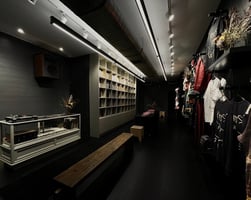Site Visit #1: Space 001 World Trade Center


A particular feeling comes over me during a deep, connected experience. My forearm muscles tighten slightly, a space below my chest expands, and my eyes prickle and well up for a moment. I feel elation, curiosity, a touch of sadness, and a sense of light. During summer's false Fall, I felt all of this at Space 001 a few weeks ago.
The site will be a “multipurpose reference library, exhibition space, and podcast studio, designed to bring Black imagination into space and time.” These functions feel especially authentic to the Institute of Black Imagination (IBI), led by artist, writer, and designer Dario Calmese. If you haven’t listened to the "Institute of Black Imagination" podcast hosted by Calmese, I highly recommend it as a resource for any creative. In a favorite episode with Ghanaian-Scottish architect, educator, and bestselling novelist Dr. Lesley Lokko (E96)—the first Black-identifying person to curate the Venice Biennale of Architecture—she speaks of the power of “grace”—a concept that resonates with me, as "wonu" means to enter with grace in Yoruba.
Located in the World Trade Center's Oculus, amidst 116 stores and restaurants, Space 001 “subverts the retail landscape by taking a space typically designed to extract and creating a place with the intention to deposit” through its model of non-transactional retail. On their website IBI poses the question: If we know what Black music sounds like, what does Black space feel like?
I was welcomed in by Somalia, the associate. I appreciated the requirement of wearing shoe-covering booties—a small but meaningful gesture to help preserve the environment. Somalia was an engaging conversationalist; the space seemed to invite real conversation, and we chatted about origins, heritage, retail, photography, and the boroughs of New York.
When she started working here, Somalia wondered why Space 001 wasn’t located in Harlem or Brooklyn. Dario explained that the location was chosen for its accessibility, as the transit hub is equally thirty minutes or less by subway from historic Black communities in Uptown, Brooklyn, and Jersey. She shared how people unfamiliar with the site are often surprised by the model. They come in ready to buy and “If it’s not for sale, what’s the point?” is a common initial reaction.
Phase I focuses on the wraparound library, showcasing the archive of cultural icon Geoffrey Holder. The collection sits within minimal interior and lighting design and is impressive, featuring a range of literature that invites exploration—fashion, design, photography, and spirituality. There is something deeply personal and enriching about the experience. Presenting these archives in such an interactive way makes inspiration, thought, and imagination feel within reach and invaluable. When Black imagination is centered, ideas are unavoidable, and possibilities seem endless. I also reflected on how the act of collecting is part of all our lives and how, through thoughtful curation and display, it is elevated to a legacy that can be experienced by all. I left the space feeling energized and wanting more—more conversation, community, and connection.
Jade



